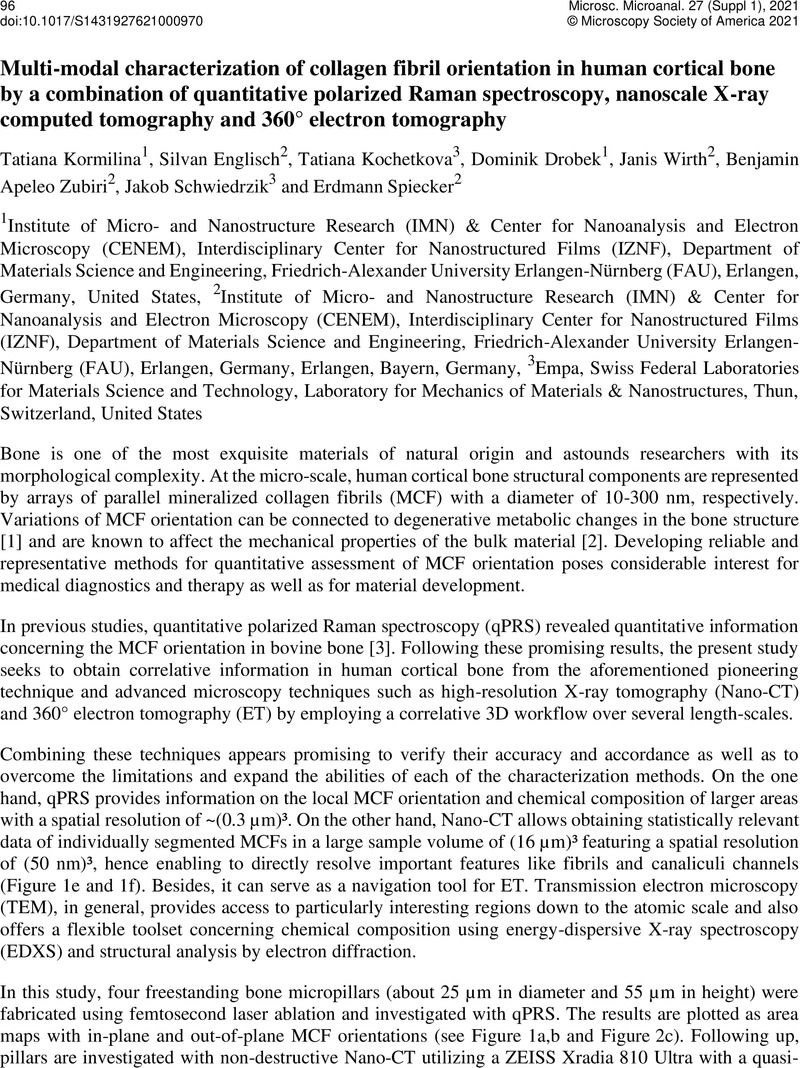No CrossRef data available.
Article contents
Multi-modal characterization of collagen fibril orientation in human cortical bone by a combination of quantitative polarized Raman spectroscopy, nanoscale X-ray computed tomography and 360° electron tomography
Published online by Cambridge University Press: 30 July 2021
Abstract
An abstract is not available for this content so a preview has been provided. As you have access to this content, a full PDF is available via the ‘Save PDF’ action button.

- Type
- Multi-Modal Multi-Dimensional Microscopy
- Information
- Copyright
- Copyright © The Author(s), 2021. Published by Cambridge University Press on behalf of the Microscopy Society of America
References
Acerbo, A. S., et al. "Alterations in collagen and mineral nanostructure observed in osteoporosis and pharmaceutical treatments using simultaneous small-and wide-angle X-ray scattering." Calcified tissue international 95.5 (2014): 446-456.CrossRefGoogle ScholarPubMed
Zimmermann, E. A., et al. "Intrinsic mechanical behavior of femoral cortical bone in young, osteoporotic and bisphosphonate-treated individuals in low-and high energy fracture conditions." Scientific reports 6.1 (2016): 1-12.Google ScholarPubMed
Kochetkova, T., et al. "Combining polarized Raman spectroscopy and micropillar compression to study microscale structure-property relationships in mineralized tissues." Acta biomaterialia 119 (2021): 390-404.CrossRefGoogle ScholarPubMed
Sommer, C., et al. "Ilastik: Interactive learning and segmentation toolkit." 2011 IEEE international symposium on biomedical imaging: From nano to macro. IEEE, 2011.Google Scholar
We gratefully acknowledge financial support by the German Research Foundation (DFG) within the frameworks of the research training group GRK1896 “In situ Microscopy with Electrons, X-rays and Scanning Probes”, the project SP648/8 “High-resolution X-ray microscopy for correlative tomography, high throughput screening and in situ mechanical testing of structural and functional materials” (Project-ID 316992193), the Collaborative Research Centre 1411 “Design of Particulate Products” (Project-ID 416229255) and the Collaborative Research Centre 1452 "Catalysis at Liquid Interfaces", as well as Special Focus Area Personalized Health and Related Technologies (SFA PHRT) iDoc Project 2017-304 and Swiss National Science Foundation (SNSF) Ambizione grant no. 174192.Google Scholar





